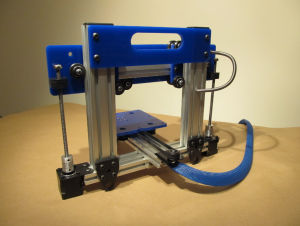Quantum ORD Bot
Ive been printing a lot lately with a couple of extruders. On my ORD bot, I use a MakerBot MK7, and on my cupcake, I use a MakerGear stepper plastruder. And what Ive come to realize is that I dont really like either of them. Or rather, I really like some elements of each, but not really the whole package for either.
The MK7 is very compact, and I really like that, especially for a smaller printer like the ORD bot. And the hot-end is uniquely short. It is about 20mm shorter than the MakerGear. That being said, the drive sucks. The filament idler is a piece of delrin that is held pressed into the filament using not a spring, but the flex of the drive housing. Theres a lot of stress there, and no adjustment. It is also driven directly off of a NEMA 17 stepper motor. That would be great if it needed to turn at high speeds, and it does mean thet theres no gearbox to take up space. But it doesnt turn at high speeds, and to get the needed torque It sucks down about 1.6A. That means the motor gets really toasty (so theres a heat sink to cool it, which takes up space), and the driver gets so hot that I have to fan-cool it or it goes into thermal shutdown. Not good.
The MakerGear, on the other hand, uses a geared stepper. It has awesome torque, even with the driver turned almost all the way down (so the driver and motor are always cool to the touch). The only problem is that the gearbox takes up a lot of space and weight. But the filament drive uses a proper ball bearing driven by springs, and the drive gear is accessible so you can clean it without dismantling the extruder. My only real kvetch is that the hot-end is long (and unlike the MK7, not all-metal).
 So I have two extruders, and in the end, I dont really like either of them. Frankly, I cant find one I really do like, but thats just because Im very picky. But I have tools, so Im not allowed to complain. I need to design my own extruder. I started with the hot-end. I wanted something like the MK7, but lower friction. The MK7 has a relatively high-friction thermal barrier, which is also made of the somewhat thermally conductive stainless steel. I dont plan on extruding any crazy polymers (such as ploycarbonate yet), so I shouldnt ever need to go above 280ºC. This means that I can use a plastic thermal barrier. Stainless is alright (an order of magnitude less conductivity than brass), but something like PTFE or PEEK (an order of magnitude less than stainless) is even better. PTFE also has crazy low friction. But its not strong, so I can take a page from MakerGear and make a hybrid insulator. I came up with a PEEK shell and a PTFE liner. The PEEK provides structure, and the PTFE provides low friction.
So I have two extruders, and in the end, I dont really like either of them. Frankly, I cant find one I really do like, but thats just because Im very picky. But I have tools, so Im not allowed to complain. I need to design my own extruder. I started with the hot-end. I wanted something like the MK7, but lower friction. The MK7 has a relatively high-friction thermal barrier, which is also made of the somewhat thermally conductive stainless steel. I dont plan on extruding any crazy polymers (such as ploycarbonate yet), so I shouldnt ever need to go above 280ºC. This means that I can use a plastic thermal barrier. Stainless is alright (an order of magnitude less conductivity than brass), but something like PTFE or PEEK (an order of magnitude less than stainless) is even better. PTFE also has crazy low friction. But its not strong, so I can take a page from MakerGear and make a hybrid insulator. I came up with a PEEK shell and a PTFE liner. The PEEK provides structure, and the PTFE provides low friction.
The heater block was fairly simple. I took a block, and added a threaded hole for attaching the nozzle and thermal barrier. I used a power resistor for a heating element, since theyre cheap and easily available. And just for kicks, I threw in a divot to stick a thermistor in. I spent a while trying to decide if I wanted a thermocouple or a thermistor. Thermocouples are good to 1600ºC (not necessary) and need no calibration (nice). But theyre incredibly noise sensitive. have one on the MK7 extruder, and even with tons of filtering cant get all the noise off the signal. So I decided on a thermistor, which is pretty much noise-proof (nice), and cheap (even better).
And so the last component is the nozzle. I have no engineering background, and so I dont really have any way to quantify the design of something like a nozzle. So I went on intuition and drew out something that just looked right. But now enough blathering, its time to make this beast.
Heres how the thermal barrier came out. I single-point cut the M8 threads on the lathe because I didnt have a die, drilled it out to 4mm, and slipped in a bit of PTFE tubing. That was pretty easy.
The heater block was another easy one. It has two holes, and was a nice quick job on the mill.
This was the hard one. I turned the nozzle out of hex bar. The threads were cut on the lathe again, but the nozzle hole was drilled on the mill. I just cant make the lathe go fast enough to use a 0.4mm bit.
And here it is assembled, with a US penny for scale. I assembled it, cemented in a resistor, and fired it up. I dont have a drive for it yet, so I just pushed filament through by hand. It went through easily, so thats a success. And it came out 22mm shorter than a MakerGear hot-end, so thats a success. I guess now I have to build a drive for it and really put it through its paces. Or make a bunch more. Or both.

